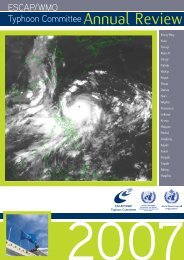TCAR - Typhoon Committee
TCAR - Typhoon Committee
TCAR - Typhoon Committee
You also want an ePaper? Increase the reach of your titles
YUMPU automatically turns print PDFs into web optimized ePapers that Google loves.
(b)<br />
Figure 12Hong Kong Observatory best track of<br />
Fengshen (blue) during 00 UTC 23 June 2008 to 00<br />
UTC 26 June 2008 and the corresponding forecast<br />
tracks by (a) JMA GSM; and (b) WRF, both initialized<br />
at 00 UTC 23 June 2008.<br />
A study was conducted to examine the potential<br />
application of EPS tropical cyclone track information<br />
for probability forecast of heavy rain using QMORPH.<br />
Results showed that the EPS tracks could provide<br />
some hints on the uncertainty of the rainfall predictions<br />
but a gross over-confidence was apparent in the<br />
probability forecasts thus generated.<br />
A meteorologist of the Observatory served as a<br />
resource person for the <strong>Typhoon</strong> <strong>Committee</strong> Roving<br />
Seminar 2009 held in Nanjing, China from 16-<br />
19 November 2009 to share with the participants<br />
his expertise and experience in the analysis and<br />
forecasting of high-impact weather associated with<br />
tropical cyclones.<br />
A multiple regression model to correlate tropical<br />
<strong>TCAR</strong><br />
CHAPTER 1 - TYPHOON COMMITTEE ACTIVITIES<br />
cyclone wind structure parameters including<br />
strong/gale/storm/hurricane wind radii in different<br />
quadrants to the tropical cyclone intensity, latitudinal<br />
position, 6-hour speed of movement and the radius<br />
of maximum wind was developed based on the<br />
multi-platform satellite surface wind analysis data<br />
generated by the National Oceanic and Atmospheric<br />
Administration (NOAA) for tropical cyclones over the<br />
western North Pacific and the South China Sea during<br />
2006-2008.Coupled with the tropical cyclone forecast<br />
track and intensity as well as surface characteristics<br />
information, the model could help generate wind<br />
forecasts at specific locations during the passage of<br />
the tropical cyclone.Its performance in forecasting<br />
surface wind at the Hong Kong International Airport<br />
was evaluated using tropical cyclone datasets for<br />
2008 and 2009. Verification results showed that the<br />
mean RMS error for 24-hour forecast was about 13<br />
km/h (7 knots).This tool would be put into operational<br />
trial in 2010.<br />
e. Regional Cooperation Achievements/Results<br />
Attachments to the Hong Kong Observatory were<br />
arranged for meteorologists from Vietnam and<br />
Malaysia. (Key Result Area 2)<br />
f. Identified Opportunities/Challenges for Future<br />
Achievements/Results<br />
Efforts would be expended by the Hong Kong<br />
Observatory to further improve the forecast of tropical<br />
cyclone intensity.<br />
2. Progress on Key Result Area 2:Minimized<br />
<strong>Typhoon</strong>-related Social and Economic Impacts.<br />
(List progress on the Strategic Goals and<br />
Associated Activities in the Strategic Plan and<br />
progress on the 2008 <strong>Typhoon</strong> <strong>Committee</strong> Annual<br />
Operating Plan goals)<br />
a. Meteorological Achievements/Results<br />
Early notification of issuance of tropical cyclone signal<br />
for increasing gale force winds was communicated<br />
to the major transport operators.Regular signal<br />
change assessment was also relayed to the container<br />
terminal to facilitate their operational planning.An<br />
enhanced level of preparedness in the transport and<br />
logistics infrastructure ensured an orderly response<br />
to the threats of tropical cyclones and facilitated more<br />
efficient traffic management to minimize the potential<br />
2009<br />
41

















